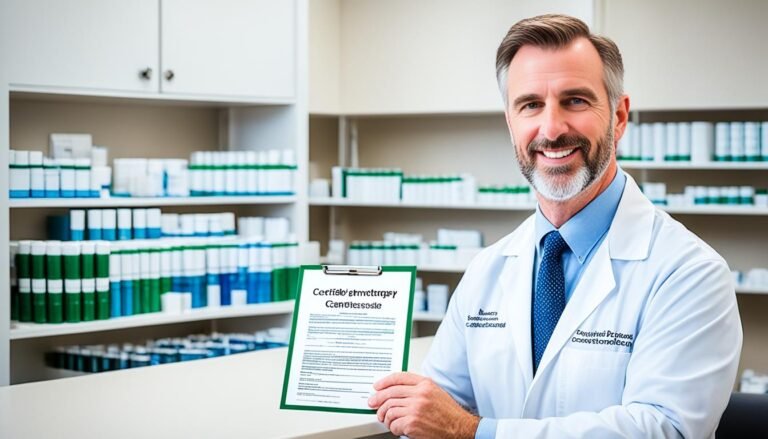What is Involved in Becoming an Emergency Medical Technician (EMT)?
Did you know over 260 million emergency medical calls happen in the U.S. each year? These calls involve critical situations where someone’s life is on the line. Emergency Medical Technicians (EMTs) jump in first to help, bringing essential care to those who need it the most. If you’ve ever thought about what becoming an EMT entails and how it can truly change lives, keep reading.
Key Takeaways:
- EMTs provide critical medical care in emergency situations with over 260 million emergency medical calls made annually in the United States.
- The certification process for becoming an EMT involves completing an accredited EMT program, passing the National Registry Emergency Medical Technician (NREMT) exam, and obtaining a state license.
- EMTs are required to meet specific training requirements, which typically include completing an accredited EMT program and participating in continuing education.
- Job duties of an EMT include responding to emergency calls, assessing a person’s condition, providing first aid, administering life-saving interventions, and communicating effectively with other medical professionals.
- The EMT career path offers opportunities for growth and advancement, with options to specialize in areas such as paramedicine or work in hospitals, private ambulance services, fire departments, and more.
EMT Certification Process
To become an EMT, you need to first finish an EMT program from an accredited place. You can find these programs at places like community colleges or with the Red Cross. After your studies, you must pass the National Registry Emergency Medical Technician (NREMT) cognitive exam. Then, you can get a state license to start working.
The EMT program teaches you the basics you need to know as an EMT. After studying, you must pass the NREMT cognitive exam. This test checks if you understand important EMT topics. Once you pass, you can apply for a state EMT license.
EMT Training Requirements
To become an EMT, you must meet specific training standards. The rules differ across states but usually include finishing a licensed EMT course. This course teaches human body basics, checking vitals, how to handle trauma, and medical emergencies.
Training programs help you learn the essential knowledge and skills for emergencies. They prepare you to check and help patients, provide treatments, and take them to the hospital safely.
State-Specific Requirements
Each state sets its unique EMT training demands and Washington State EMT certification requirements will differ slightly to Californian ones. You might need a certain number of classroom hours, practical training, and time in hospitals. Some states even ask for background checks and drug tests. It’s key to look into what your state requires to get your certification.
Enrolling in an approved EMT course is crucial. You can find these programs in community colleges, tech schools, and emergency centers. They cover important subjects like first assessments, childbirth in emergencies, and how to treat trauma.
EMTs must also keep their CPR skills up to date. Being CPR-certified means you can help save lives in emergencies. You can do a CPR course through groups like the American Red Cross or the American Heart Association.
Continuing education is a must for EMTs. It helps them learn about new medical findings and better ways to care for people. These courses allow EMTs to learn new skills and stay sharp in their work.
Benefits of Meeting Training Requirements
Meeting the EMT training needs is key. It ensures you’re ready to give skilled and caring help to those in emergencies. The training gives you the confidence and knowledge to act fast and help those who need it.
It also shows you’re serious about your job in emergency medical services. By finishing a course and doing continued training, you prove you’re dedicated to getting better at what you do.
Lastly, it’s a must for getting EMT jobs. Certification is needed in most states to work as an EMT. Employers look for certified EMTs who have had proper training. This ensures they’re hiring someone with the right skills and knowledge.
EMT Job Duties
EMTs are vital for giving fast medical help and moving people who are very hurt or sick. They do many things that need them to act fast, care deeply, and talk well.
Here are some key EMT job duties:
- Responding to emergency calls: They’re the first help at an emergency. They quickly see what’s needed and start care right away.
- Assessing a person’s condition: They check vital signs like heart rate and blood pressure. This tells them how serious the person’s condition is.
- Providing basic first-aid treatment: They start care with wound dressing and set broken bones. They also stop heavy bleeding.
- Stabilizing individuals in distress: Their job is to make sure critical patients are okay first. They might use special moves to help with the patient’s breathing or give oxygen.
- Administering life-saving medical interventions: They know how to do CPR, use a defibrillator, and other crucial treatments.
- Determining the appropriate medical facility for transport: They pick the best hospital for the patient in need. This depends on how bad the injury is and where they are.
- Documenting patient care: EMTs keep careful notes on their care. This includes the patient’s health information, treatments, and how they respond to help.
- Effective communication with other first responders and medical professionals: They work closely with others like firefighters and doctors. This makes sure everyone is doing the right thing for the patient.
In their work, EMTs deal with a lot of stress and have to act quickly. Being calm, focused, and caring is key in their job. They help save lives and comfort those in emergency situations.
EMT Career Path
Being an Emergency Medical Technician (EMT) is a gratifying job. It offers many chances for you to grow. With more experience and education, you can rise to higher certification levels. You can also focus on different parts of emergency medicine.
Becoming a Paramedic
EMTs can step up to become paramedics. This additional training lets you do more complicated medical actions. As a paramedic, you take on more tasks and care for severely ill or injured patients.
Specialization in Emergency Medicine
EMTs might choose to specialize in certain areas of emergency medicine. You can become an expert and give special care, like to older or younger patients. You could work in hospitals, surgery centers, or with specific medical services.
- Working in hospitals: EMTs here give quick care inside the hospital with doctors and nurses for critical patients.
- Surgery centers: EMTs in these centers look after patients before and after operations, ensuring their well-being.
- Private ambulance services: They offer emergency care outside hospitals, responding to accidents, homes, or events.
- Specialized populations: Some EMTs care for specific groups, like the elderly or kids, who have unique medical needs.
Choosing a specialty lets you gain unique skills. This helps you greatly impact the care you give.
Continued Education and Advancement
To excel in your career, keep learning. This means staying informed about new medical care methods. Seeking education helps you grow your skills and knowledge, keeping you ahead in the field.
Ongoing education can lead to higher EMS jobs, like becoming a supervisor. These positions involve leading EMT teams for a better emergency medical response.
Some EMTs decide to become doctors or nurse practitioners. This choice broadens their career horizons. They can then do more for patients in need.
The EMT career has many paths for personal and professional growth. It lets you impact and help those in critical medical situations.
EMT Skills Development
Working as an EMT is about learning specific skills. EMTs use quick thinking to react in emergencies. They solve problems to make tough medical calls.
EMTs show they care with warmth and understanding. They need to talk well to help patients and work with doctors.
Listening closely is important for EMTs. They must also be patient and kind, especially when people are very upset.
Being mentally tough is key for EMTs. They face tough events but must stay calm and helpful.
Having a strong body is important for an EMT. They often lift and move people. So, they need to be strong and fit.
EMT careers include lots of learning. EMTs must always improve their knowledge and skills to give the best help.
Examples of EMT Skills
To show EMTs’ skills, here are some examples:
- Quickly assessing a patient’s condition
- Providing basic first aid and life-saving interventions
- Administering cardiopulmonary resuscitation (CPR)
- Effectively communicating with patients, their families, and healthcare professionals
- Properly utilizing medical equipment and devices
- Operating and maneuvering an ambulance
- Working as part of a team in high-pressure situations
- Documenting patient care accurately and thoroughly
These skills prove EMTs are well-rounded. They combine medical know-how with technical and people skills to help others.
| Skills | Description |
|---|---|
| Fast decision-making abilities | EMTs must be able to think quickly and make critical decisions in emergency situations. |
| Problem-solving skills | EMTs need to solve problems and adapt to unexpected challenges during medical emergencies. |
| Empathy and understanding | EMTs must show compassion and empathy towards patients while providing medical care. |
| Effective communication | EMTs need to have excellent communication skills to interact with patients, their families, and medical professionals. |
| Good listening skills | EMTs should be able to listen actively and attentively to patients to gather important medical information. |
| Patience and compassion | EMTs must remain patient and compassionate when dealing with patients in stressful situations. |
| Mental resiliency | EMTs need to be mentally strong and resilient to handle traumatic events and high-pressure situations. |
| Physical fitness | EMTs must be physically fit to perform physically demanding tasks and provide effective care. |
EMT Certification Exam
The EMT certification exam is an important step in your journey to become a certified EMT. It’s run by the NREMT and tests your knowledge and skills. These are needed for you to start working as an EMT.
It has two main parts: a written test and a practical test. The written test checks what you know about caring for people in emergencies. It asks about checking patients, keeping their airways clear, handling medical crises, and more. Studying hard for this part is key to passing.
Studying and using sample questions can boost your chances of doing well. Make sure you’re up to speed on all the test topics and know what to expect during the exam.
The practical test is all about showing what you can do in real emergency scenarios. You’ll have to assess patients, manage their airways, and handle splinting and bandaging. Lots of practice beforehand is crucial for confidence and success.
Preparing for the EMT Certification Exam
Getting ready for the EMT exam involves a few key steps:
- Join a top EMT training course that covers everything you need to know for the exam.
- Use study guides and practice tests recommended by the NREMT or other trusted sources.
- Review all your course materials, books, and online info to be sure you understand the important stuff well.
- Get a lot of hands-on practice with emergency response skills and other key procedures.
- Team up with other EMT students through study groups or online forums to exchange tips and knowledge.
- Think about going to review courses or workshops made to help you pass the EMT exam.
You need to pass both the written and the practical tests to get your EMT certificate. After this, you can apply for a state license. Then, you can work as an EMT and begin a rewarding career in emergency care.
EMT Job Opportunities
EMTs have many job options waiting for them. They can work in hospitals, surgery centers, and private ambulance services. They also find jobs in fire departments, police departments, and colleges. Other possibilities include working at large hotels, amusement parks, and national parks.
EMTs are vital in various settings. They may provide immediate care in emergency rooms or help in the field. Their job is to save lives and give critical care.
“Working as an EMT lets you help at the forefront of emergency care. It’s rewarding, making a big impact in your community.”
The need for EMTs is growing. This is because of natural disasters, more elderly people, and the COVID-19 pandemic. These events mean more people need emergency care. As a result, there will be more jobs for EMTs.
EMTs will see more opportunities in their field. Their role in emergency care will become even more critical, as the need for their services is expected to rise.
| Factors contributing to job opportunities for EMTs: | Projected growth |
|---|---|
| Natural disasters | + |
| Aging population | + |
| Ongoing COVID-19 pandemic | + |
Note: The table above highlights factors that make EMT roles more crucial. It explains how these factors lead to a higher demand for emergency care.
Career Advancement Opportunities for EMTs
EMTs can grow their careers. They can become paramedics with more training. Paramedics do advanced medical procedures to give better care.
Or, EMTs might choose to work in specific emergency care areas. This could be in hospitals, surgery centers, or with certain patient groups. It lets them focus on special needs.
EMTs can have a rewarding career with the right steps. It includes gaining experience, more education, and staying dedicated to their work.
EMT Employment Outlook
The job outlook for EMTs is looking up with a lot of growth expected. The US Bureau of Labor Statistics says EMT and paramedic jobs are to increase by seven percent through 2031. This will add over 20,000 new positions each year.
This uptick in jobs is due to a few reasons, one being the greater need for emergency medical help. With the population growing, so does the need for fast medical care in emergencies.
The growing number of older adults also boosts the need for EMTs. As people age, they often require emergency medical help. This, in turn, raises the need for EMTs trained to provide quick care.
Events like the COVID-19 pandemic have shown how vital EMTs are in the health system. Their ability to react fast and give urgent care saves lives. This keeps the need for skilled EMTs high.
This means EMTs will have many job chances in places like hospitals, ambulance services, and fire departments. The increasing need also leads to chances for EMTs to progress in their careers.
To sum up, the job prospects for EMTs are good, with more positions opening up and new prospects. EMTs are critical for urgent medical care. Their abilities are very important in today’s health care world.
Recommended EMT Courses
To start your journey as an Emergency Medical Technician (EMT), taking the right EMT courses is key. The Become an EMT Specialization course at the University of Colorado is a top choice. It’s an online program that teaches you how to care for all kinds of patients, handle time-critical health issues, and deal with medical emergencies.
In this course, experienced teachers will lead you through online lessons, practical simulations, and hands-on practice. You will learn about emergency patient checks, keeping airways open, giving medicine quickly, trauma first aid, and the laws around medical emergencies outside a hospital.
By finishing this course, you’ll really understand the key parts of emergency medical care needed to work as an EMT. The University of Colorado program is online and lets you learn on your own schedule. Yet, you’ll get expert support to help you along the way.
Many other schools and groups also offer courses for EMTs. Places like the Red Cross are well-known for their good training and the complete lessons they give.
It’s vital to pick a course that has been approved and fits what your state needs. Courses that have been checked and approved meet the best standards. They will make sure you are ready to take on the work of an EMT.
Choose a course that matches how you like to learn and when you can study, as well as what you plan for your career. Think about how good the school or group is and how well their students do in getting their EMT papers.
As you start looking for an EMT course, check out all the options and pick the one that really fits you. Good learning and training are key to being a great, caring EMT who can help save lives.
| EMT Course Provider | Course Details |
|---|---|
| University of Colorado | Become an EMT Specialization: Comprehensive online program providing knowledge and skills in emergency medical care |
| Red Cross | Nationwide recognized EMT training programs |
Conclusion
Becoming an Emergency Medical Technician (EMT) can be a very rewarding journey. You need to complete a certification process and meet specific training needs. As an EMT, you help save lives by providing vital care in emergencies.
The EMT career path is full of chances to grow. With more experience and education, you can aim for higher certifications. This could lead you to become a paramedic or work in specialized areas of emergency medicine like in hospitals or specific communities.
The job outlook for EMTs is looking up. There’s an expected rise in job opportunities because more people need emergency medical help. As an EMT, you can look forward to a career where you not only save lives but also provide important healthcare services to those in need.







